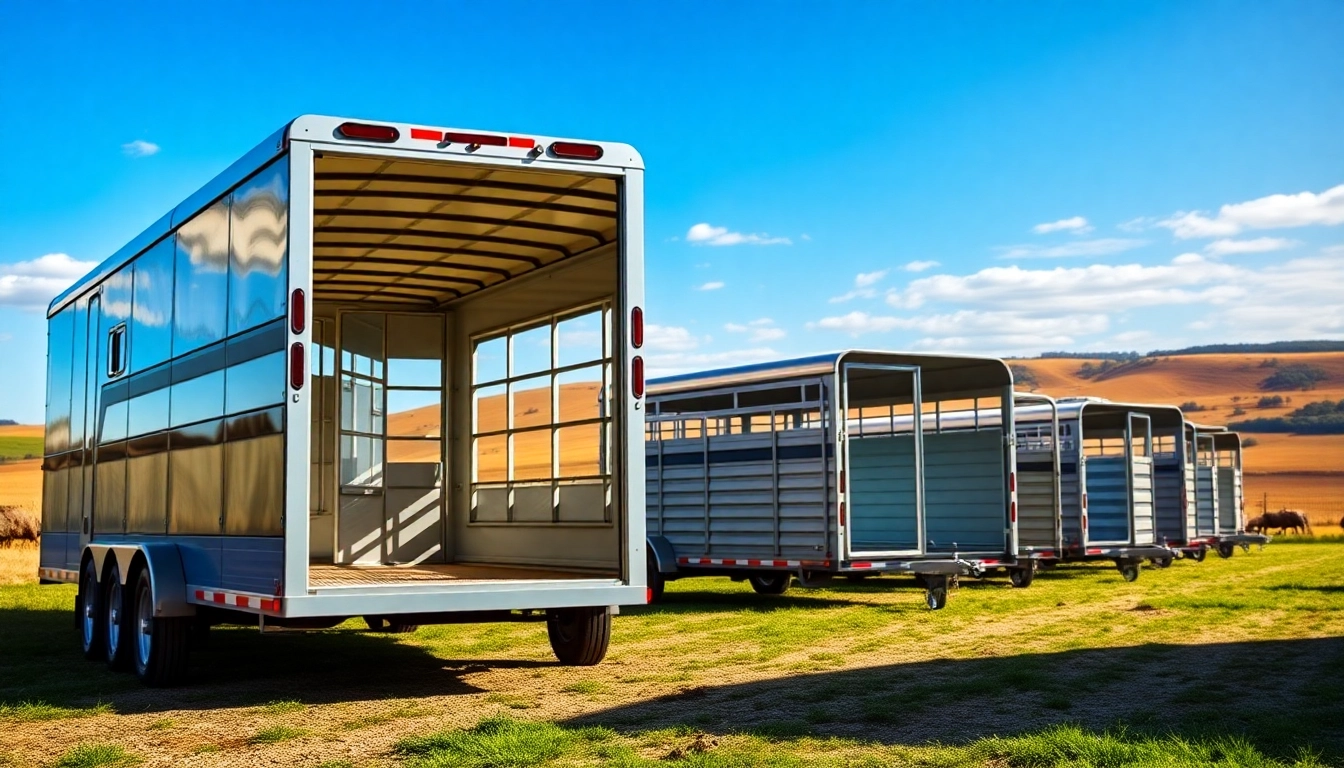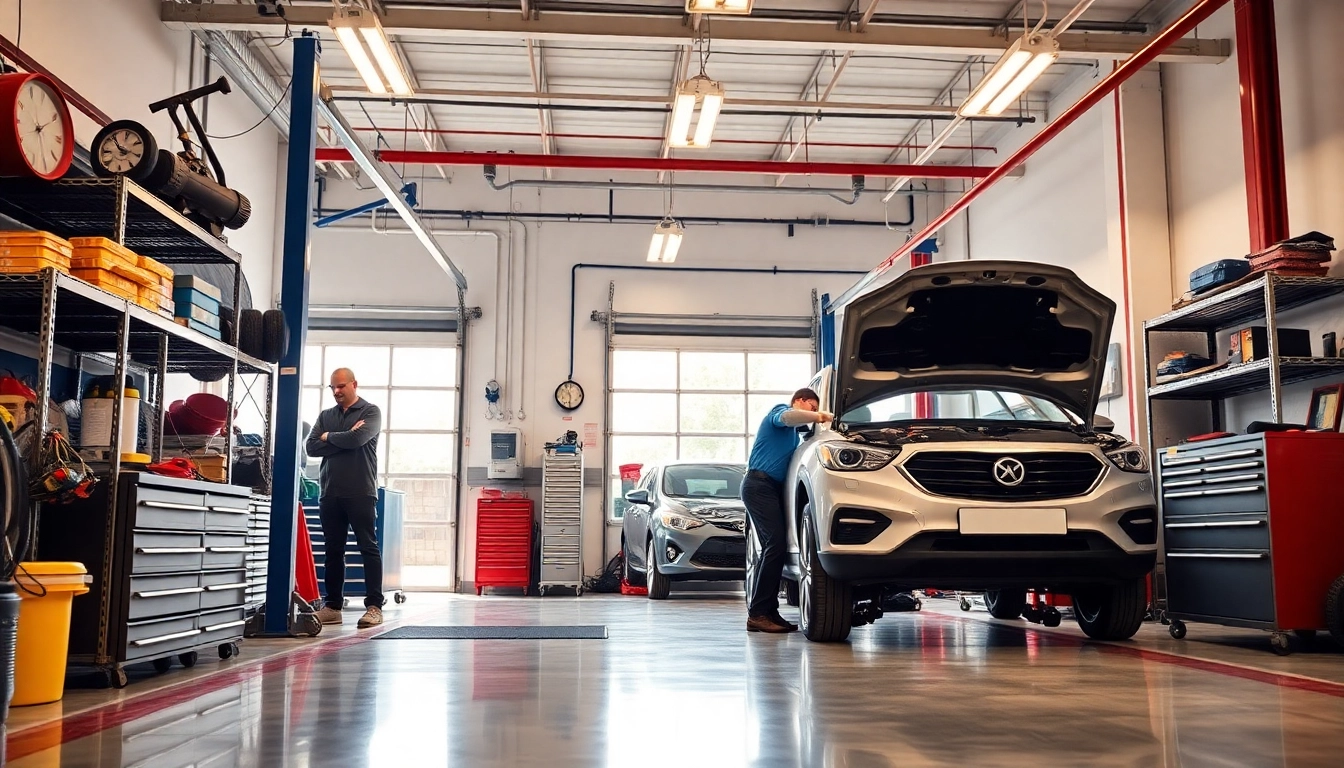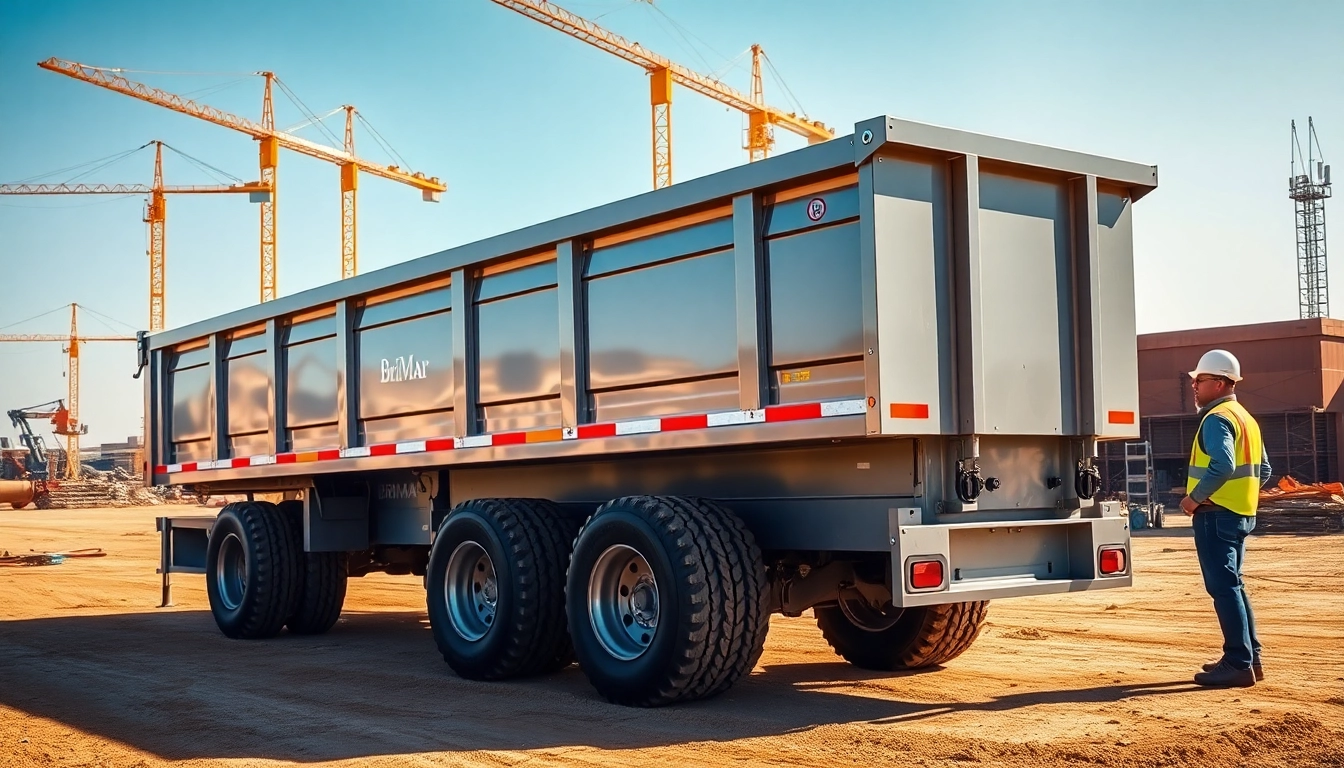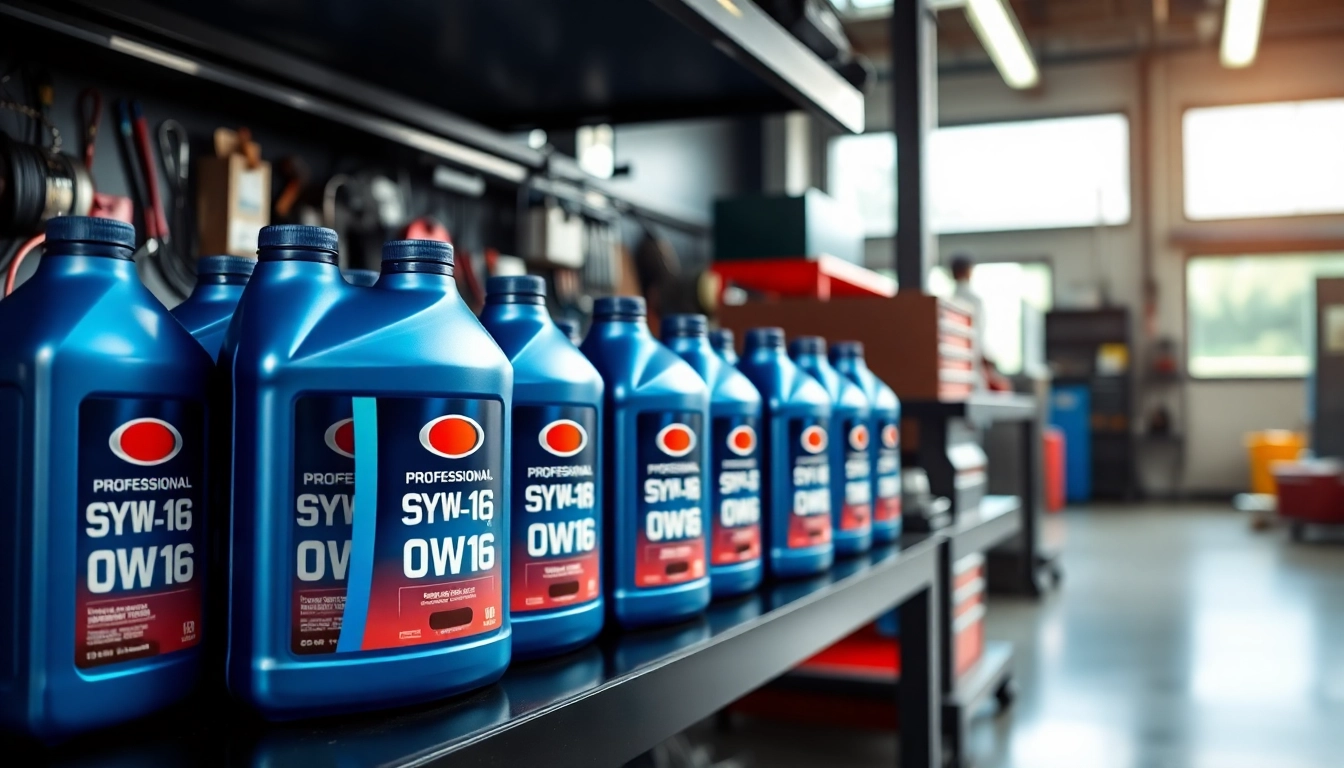Understanding Stock Trailers
What Are Stock Trailers?
Stock trailers are specialized vehicles designed for the safe and efficient transportation of livestock. Their design is tailored to accommodate a variety of animals, including cattle, horses, and sheep, offering comfort and security during transit. These trailers are generally sturdily built with materials that can withstand the weight of livestock while providing ample ventilation. As agriculture has become more advanced, the necessity for reliable and durable transport solutions has made stock trailers an essential investment for farmers and ranchers alike. To explore high-quality options, consider checking out Stock Trailers that can meet your specific needs.
Key Features of Stock Trailers
Stock trailers are characterized by several key features that enhance their functionality. First among these is the robust construction material that often includes galvanized steel or aluminum, which ensures durability and weather resistance. Additionally, many stock trailers come equipped with adjustable dividers that allow farmers to customize the interior space according to the type and size of livestock being transported.
Another feature is the ample ventilation system, which is crucial for the comfort of the animals during transport. Features such as roof vents and side vents help regulate temperature and prevent overheating, particularly in warm weather. The flooring in stock trailers is also designed with non-slip surfaces to offer secure footing for the animals, thereby reducing the risk of injury. Furthermore, many stock trailers include reinforced loading ramps for easy access, and some models feature hydraulic brakes for improved safety during transit.
Types of Stock Trailers Available
There are several types of stock trailers on the market, each designed for specific needs and preferences. These generally fall into three main categories: gooseneck trailers, bumper pull trailers, and multi-animal trailers.
Gooseneck trailers are attached to a pickup truck via a hitch that extends over the truck’s bed, providing improved stability and towing capacity. These are particularly useful for transporting larger loads. Bumper pull trailers, on the other hand, connect to a vehicle at the rear, making them more accessible for casual use and easier to maneuver.
Multi-animal trailers are designed with multiple compartments, allowing for various types of livestock to be transported simultaneously. This feature is particularly beneficial for farmers with diverse livestock needs, as it maximizes efficiency during transport. Understanding the distinctions among these trailer types helps in selecting the model that best fits your requirements.
Benefits of Using Stock Trailers
Enhanced Efficiency for Transporting Livestock
One of the primary benefits of using stock trailers is the efficiency they bring to the operation of transporting livestock. These specialized trailers are designed not only to protect animals during transport but also to streamline the loading and unloading process. When livestock transport is efficient, it minimizes the time that animals are in transit, thus reducing stress levels for both the animals and handlers.
An efficient transport setup translates into better overall productivity. For instance, quick transport on well-designed stock trailers means farmers can allocate more time to other essential tasks on their farms rather than being tied down by complex logistical challenges. High-quality trailers can manage heavier loads and offer smoother rides, ultimately ensuring that livestock reaches their destination safely and in a timely manner.
Durability and Longevity
Durability is another significant advantage of investing in stock trailers. Designed to withstand rigorous conditions, these trailers are made from strong materials that can endure wear and tear from transporting livestock in various environments. A well-constructed stock trailer can last for years, making it a cost-effective choice for any ranch or farm.
Properly maintained trailers can serve for decades, thus yielding a solid return on investment. Over time, the initial expenditure on a quality stock trailer translates to significant savings in repair and replacement costs, particularly when considering the prolonged operational lifespan.
Cost-Effective Solutions for Farmers
Cost-effectiveness is a critical consideration for anyone involved in agriculture. Stock trailers, while representing a significant initial investment, often lead to lower operating costs over time. By reducing the risk of injury or stress to livestock during transport, farmers can minimize veterinary bills and losses related to livestock stress or injuries incurred in transit.
Furthermore, streamlining transport means more efficient use of labor and time, which can translate into financial gains. The long-term value of stock trailers is typically evident in improved productivity and reduced operational headaches, allowing farmers to focus on expanding their business rather than dealing with costly disruptions.
How to Choose the Best Stock Trailers
Assessing Your Specific Needs
The selection of the right stock trailer hinges on a thorough assessment of specific needs. Start by considering the types of livestock being transported and their corresponding space requirements. Different animal sizes and temperaments necessitate different features, such as dividers and ventilation.
Additionally, consider the frequency of transport. If livestock is transported regularly, investing in a more robust model might be warranted to handle ongoing wear and tear. Conversely, for occasional use, a more basic model could suffice. Evaluating your transport needs holistically will aid in making an informed purchasing decision that aligns with your operational goals.
Evaluating Trailer Capacity and Size
Understanding the appropriate capacity and size for your stock trailer is vital. Each type of livestock has different spatial needs, and overcrowding can lead to stress and injury. It is essential to choose a trailer that can comfortably accommodate your animals, giving them enough space to stand, lie down, and shift positions during transport.
Remember to factor in not only the current stock you own but also potential future growth. If you plan to increase your herd size or branch out into other types of livestock, select a trailer that will meet future needs instead of merely addressing current requirements. Common guidelines suggest providing a minimum of 10-12 square feet of space for an average cattle animal, depending on its size.
Understanding Materials and Build Quality
The materials and build quality of a stock trailer play a significant role in its performance and longevity. Generally, trailers are made from materials such as steel or aluminum. Steel options are typically heavier and more durable, but they may also be prone to rust if not treated properly. On the other hand, aluminum trailers are lighter, more resistant to corrosion, and provide better fuel efficiency during towing.
Assessing the quality of construction is crucial; look for features like reinforced seams and sturdy welds, which enhance overall strength. Also, consider the finish on the trailer; a high-quality paint or galvanization process can provide additional protection against the elements. Prioritizing quality in your selection process is essential for a trailer that lasts.
Maintaining Your Stock Trailers
Regular Maintenance Tips
Maintaining your stock trailer is crucial for ensuring it remains in optimal working condition. Regular maintenance can extend the lifespan of the trailer and help avoid costly repairs. Begin by conducting routine inspections to identify and address any issues early. Key areas to inspect include the brakes, tires, lights, and structural integrity.
It is also advisable to clean the trailer regularly, removing any debris or waste that could lead to corrosion or odor retention. Check the flooring for signs of wear and tear, as damaged flooring can pose safety risks to the animals during transport. Ensure all mechanical parts are lubricated, and the electrical systems are functional. Following a consistent maintenance schedule will keep your trailer ready for use at all times.
Signs of Wear and Tear
Being attuned to signs of wear and tear can prevent minor issues from escalating into significant problems. Look for bubbling paint or rust spots, which can indicate corrosion. Inspect the tires for tread wear and check air pressure regularly to maintain optimal performance.
Listen for unusual sounds while transporting; noises can signal mechanical problems that need to be addressed. Additionally, observe for any changes in how your livestock behaves during loading or transport, as these can reflect underlying issues with the trailer. Proactive monitoring will ensure safety and comfort for your livestock.
Upgrades to Consider for Longevity
Certain upgrades can enhance the longevity and functionality of your stock trailer. Consider investing in advanced braking systems, such as electric or hydraulic brakes, which can significantly improve safety.
Other worthwhile upgrades may include installing an enclosed area for livestock to protect them from extreme weather conditions or adding extra ventilation systems if you frequently transport animals in hot climates. Enhancements like shock absorbers can also improve ride comfort, further ensuring the well-being of your livestock during transit.
Trending Innovations in Stock Trailers
Technological Advancements in Design
The stock trailer industry has witnessed significant technological advancements in recent years, focusing on improving design, safety, and efficiency. Innovations such as integrated GPS tracking systems allow farmers to monitor the trailer’s location in real-time, enhancing the safety of livestock during transport.
Moreover, manufacturers are exploring smart technology integration, offering remote monitoring capabilities for critical systems. For instance, sensors can provide alerts about tire pressure, load weight, and even temperature fluctuations inside the trailer. Such technologies empower farmers to take preemptive measures, ensuring the safety and comfort of animals during transit.
Eco-Friendly Trailer Options
With the increasing focus on sustainability, many manufacturers are developing eco-friendly stock trailers. These trailers utilize innovative materials, such as recycled aluminum or composite materials, that reduce environmental impact.
Additionally, some models are designed to maximize fuel efficiency when towed, further decreasing carbon emissions. Eco-friendly designs demonstrate a commitment to sustainable farming practices, attracting customers who prioritize environmental responsibility in their agricultural endeavors.
Market Trends and Future Directions
The stock trailer market is evolving based on the changing needs of modern agriculture. One notable trend is the increasing preference for customizable trailers that can be tailored to specific farming operations. This trend reflects farmers’ desires for flexibility and adaptability in their equipment.
Another emerging direction is the integration of enhanced safety features to prevent accidents and protect animal welfare. As regulations around livestock transportation tighten, trailers equipped with safety features will become a necessity. As the market continues to mature, stakeholders will prioritize innovations that enhance functionality while ensuring the safety and comfort of livestock.














Leave a Reply